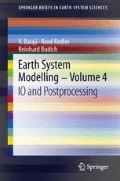Abstract
While Earth System models have been among the very largest consumers of high-performance computing (HPC) cycles, they very rarely figure on lists of computing tours de force, such as the Gordon Bell prize. Among the reasons are that ESMs, especially climate models, tend to be among the most I/O intensive applications in HPC.
Access this chapter
Tax calculation will be finalised at checkout
Purchases are for personal use only
References
Balaji V, Adcroft A, Liang Z (2007) Gridspec: a standard for the description of grids used in earth system models
Cornillon P, Gallagher J, Sgouros T (2003) OPeNDAP: accessing data in a distributed, heterogeneous environment. Data Sci J 2:164–174
Hallberg R, Gnanadesikan A (2006) The role of eddies in determining the structure and response of the wind-driven southern hemisphere overturning: results from the modeling eddies in the southern ocean (MESO) project. J Phys Oceanogr 36(12):2232–2252
Jones PW (1999b) First- and second-order conservative remapping schemes for grids in spherical coordinates. Mon Wea Rev 127(9):2204–2210
Lawrence B, Drach R, Eaton B, Gregory J, Hankin S, Lowry R, Rew R, Taylor K (2005) Maintaining and advancing the CF standard for earth system science community data
Lofstead J, Klasky S, Schwan K, Podhorszki N, Jin C (2008) Flexible IO and integration for scientific codes through the adaptable IO system (ADIOS). In: Proceedings of the 6th international workshop on challenges of large applications in distributed environments, ACM New York, pp 15–24
Michalakes J, Dudhia J, Gill D, Henderson T, Klemp J, Skamarock W, Wang W (2004) The weather research and forecast model: software architecture and performance. In: Proceeding of the eleventh ECMWF workshop on the use of high performance computing in meteorology, pp 25–29
Schulzweida U, Kornblueh L, Quast R (2006) CDO users guide. Climate data operators, version 6 1(6), http://code.zmaw.de/projects/cdo
Williams K, Ringer M, Senior C, Webb M, McAvaney B, Andronova N, Bony S, Dufresne J, Emori S, Gudgel R et al (2006) Evaluation of a component of the cloud response to climate change in an intercomparison of climate models. Clim Dynam 26(2):145–165
Zender C (2008) Analysis of self-describing gridded geoscience data with NetCDF operators (NCO). Environ Modell Softw 23(10):1338–1342
Author information
Authors and Affiliations
Corresponding author
Rights and permissions
Copyright information
© 2013 The Author(s)
About this chapter
Cite this chapter
Balaji, V. (2013). ESM I/O Layers. In: Earth System Modelling - Volume 4. SpringerBriefs in Earth System Sciences. Springer, Berlin, Heidelberg. https://doi.org/10.1007/978-3-642-36464-8_3
Download citation
DOI: https://doi.org/10.1007/978-3-642-36464-8_3
Published:
Publisher Name: Springer, Berlin, Heidelberg
Print ISBN: 978-3-642-36463-1
Online ISBN: 978-3-642-36464-8
eBook Packages: Earth and Environmental ScienceEarth and Environmental Science (R0)

